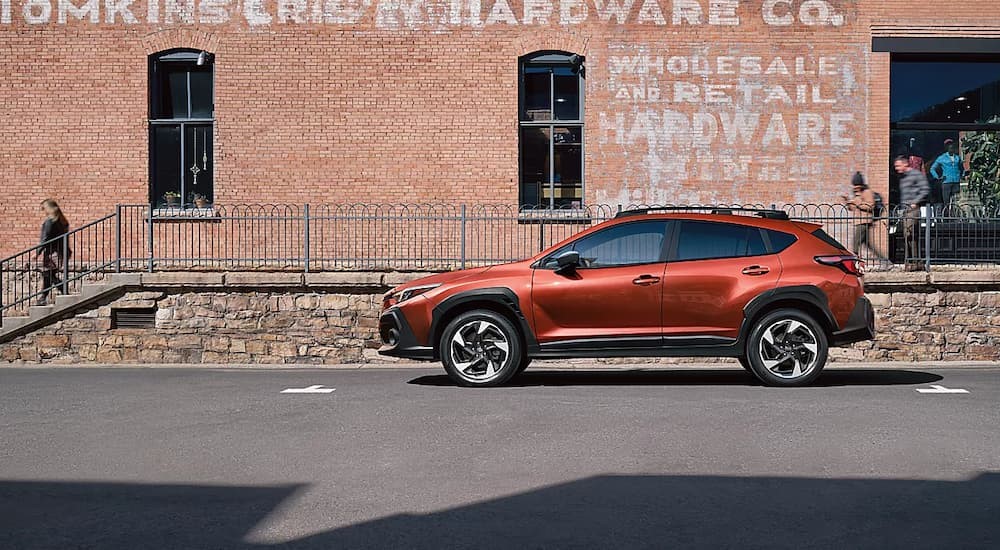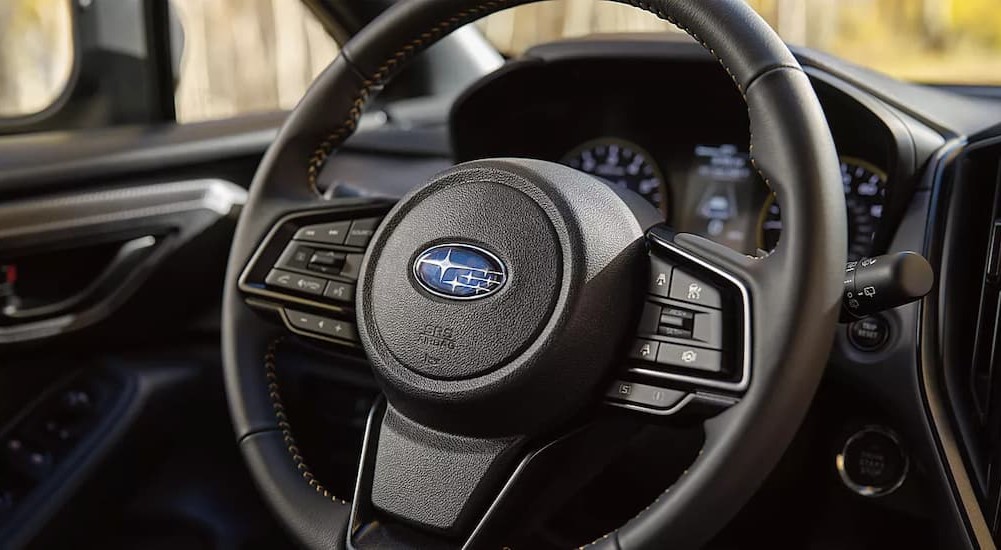The Subaru Crosstrek is one of the most popular models from the Japanese automaker and for many great reasons. As a subcompact crossover, the Crosstrek has been a staple in the Subaru lineup since 2013. It’s remarkably versatile and can comfortably accommodate passengers and cargo with its two-row design. Its smaller footprint adds to its agility, and the manufacturer outfits every Subaru Crosstrek for sale with a Symmetrical All-Wheel Drive system that delivers all-season and all-terrain confidence mile after mile.
The Crosstrek’s Symmetrical All-Wheel Drive is part of its appeal, as is the Boxer engine under its hood. For most people, the Boxer engine and all-wheel drive are synonymous with Subaru. The automaker has relied on this incredible combination for decades, adding exceptional value and appeal to its fleet. In fact, Subaru’s reliance on the Boxer engine is so ingrained that many assume the engine design is a product of Subaru’s ingenuity. That isn’t exactly the case, but that isn’t to say that Subaru hasn’t played an integral role in perfecting the engine’s design.
The Basics of Engine Design: From Inline to Flat
Internal combustion engines all operate on the same principle, relying on a mixture of air and fuel to create miniature explosions and generate power. But while the result is the same, engines come in various configurations to accommodate different vehicles and performance needs. This variation is apparent across the automotive industry, with automakers offering multiple powertrain options that deliver a broad range of horsepower and torque, whether modestly sipping fuel to heighten efficiency or optimizing low-end torque for towing heavy loads.
The world’s leading automakers typically rely on inline or V engines, which position the pistons vertically. However, Subaru takes a different approach, equipping models like the Crosstrek with Boxer engines. Instead of being configured vertically, the engine is flat with horizontally opposed pistons. But what does this layout mean? Why has it become a staple in the Subaru lineup?
The Origins of the Flat Engine
Subaru’s widespread use of the Boxer engine leads many to assume the automaker developed the unique design, but that isn’t the case. Decades before Subaru opened its automotive division in the 1950s, Carl Benz unknowingly shaped the automotive landscape when he invented the flat engine in 1897. Originally known as the contra engine, Benz’s flat 1.7L engine featured a distinct design with dual cylinders slightly offset and positioned on opposite sides of the crankshaft. The opposing cylinders, mimicking how a boxer punches with his hands, achieved an output of five hp and set the stage for an incredible lineage of performance.
From its humble beginnings, the Boxer design gained more traction and was employed in many early automobiles, including the Ford Model A. It even saw success in aviation, powering aircraft from the early Pearse monoplane to the iconic Piper Cub. However, the flat engine really took off when Volkswagen outfitted the Type 1 Beetle with an air-cooled four-cylinder version in the late 1930s. From there, Porsche adopted the Boxer engine, singing its praises as the perfect solution for its speed-hungry race cars and performance icons. Other brands, like BMW, jumped on the bandwagon, outfitting its motorcycle fleet with flat-twin engines that continue to differentiate the BMW lineup today. Then, in the 1950s, Subaru joined the flat-engine craze.
The Subaru Advantage: Boxer Performance and All-Season Confidence
Subaru is one of the few modern automakers to use a Boxer engine across its lineup, which raises several questions. If everyone else jumped ship and ditched the Boxer engine, why hasn’t Subaru followed suit? Why do the Crosstrek, Forester, Outback, and the rest of the Subaru fleet still rely on this unique engine design? What does this steadfast dedication to the Boxer engine say about Subaru?
Think about this––Porsche still widely uses the Boxer engine. Subaru, an automotive brand known for its practicality, sits alongside an automaker revered for performance, luxury, and innovation. That’s excellent company to keep, don’t you think? So, why the Boxer engine?
Models like the Subaru Crosstrek pack a one-two punch because of the Boxer engine and Symmetrical All-Wheel Drive. The Boxer engine is advantageous because its design is lightweight and offers a lower center of gravity, translating to better dynamics. The lower center of mass improves the vehicle’s stability, which is a must in a sports car like a Porsche 911 but is just as helpful in an all-wheel drive SUV like the Crosstrek destined to tackle slippery terrain.
With the Boxer engine design offering a lower center of gravity, your control behind the wheel of the Crosstrek is heightened. Subaru takes this control to the next level and improves the Crosstrek’s handling with a Symmetrical All-Wheel Drive system that complements the Boxer engine’s horizontally opposed layout. Since everything is mounted symmetrically in a straight line, the Crosstrek’s chassis is more stable and less prone to rolling or pitching when navigating corners, braking quickly, or maneuvering through slippery conditions. This unique combination is considered Subaru’s greatest advantage since it’s standard across the automaker’s lineup and instills greater peace of mind mile after mile.
Behind the Wheel of the Crosstrek: A Decade-Long Progression of Performance
With Subaru introducing Symmetrical All-Wheel Drive in the 1970s, the automaker had it perfected by the time the Crosstrek debuted in 2013. The first-generation Crosstrek immediately turned heads as the most efficient and engaging all-wheel drive crossover in the country. At the heart of its performance was none other than a 2.0L Boxer engine producing 148 hp and working effortlessly to optimize traction and handling with the standard Symmetrical All-Wheel Drive system. Even more impressive, the 2013 Crosstrek’s Boxer engine modestly sips fuel and is rated for an estimated 32 MPG on the highway with Subaru’s Lineartronic Continuously Variable Transmission.
The first-generation Crosstrek set a benchmark in the segment, with Subaru successfully raising the bar with each subsequent model. We see this progression and the evolution of the Boxer engine and Symmetrical All-Wheel Drive system culminate in the all-new 2024 Crosstrek, which is more powerful and capable than ever. Today, additional features like Active Torque Vectoring complement the all-wheel drivetrain and Boxer engine, with up to 9.3 inches of ground clearance encouraging drivers to confidently explore more technical terrain beyond the pavement.
Most notably, the 2024 Crosstrek’s powertrain lineup caters to a broader range of driving needs. The standard 2.0L four-cylinder Boxer engine is more powerful than ever, producing 152 hp without compromising the Crosstrek’s impressive fuel economy of 34 MPG on the highway. Top-tier trims like the Sport and Limited push the envelope with a 2.5L Boxer engine producing 182 hp. This continuous progression means that a new generation of drivers can enjoy the unique capabilities of the Boxer engine for themselves.
The Power of Being Different
Subaru has an exceptional reputation for offering drivers tangible value without compromise. The automaker doesn’t ask us to spend more for all-season confidence but delivers it freely in models like the Crosstrek by making its Symmetrical All-Wheel Drive system standard across the board. This confidence is also ingrained in Subaru’s reliance on the Boxer engine, a design developed in the late 1890s, long before Subaru opened its doors.
Today, Subaru is one of only a handful of automakers to rely on a flat-engine layout, which speaks volumes about the brand and its dedication. Subaru recognizes the importance of doing everything possible to give drivers the confidence they deserve behind the wheel, fine tuning the Boxer engine year after year, as we see in the evolution of the Crosstrek over the last decade. Unique SUVs like the Crosstrek are rarities in what can often be a rather bland segment, but Subaru uses the Boxer engine and standard all-wheel drive to give drivers more value and better performance in any condition. That distinction is compelling in a highly competitive industry, earning Subaru and models like the Crosstrek a well-deserved and incredibly loyal following.






